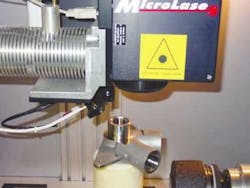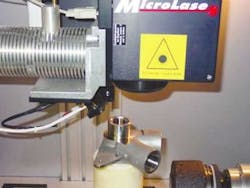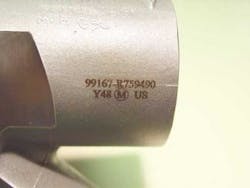Boosting consistency and productivity
The Hamilton Sundstrand manufacturing operation in York, Nebraska, supplies precision-machined components used in commercial and corporate aircraft, military aviation and aerospace. Based in Windsor Locks, Connecticut, Hamilton Sundstrand is a subsidiary of United Technologies Corp., a global suppliers of technologically advanced aerospace and industrial products.
The York plant produces parts that go into integrated-drive generators, ram-air turbines, pumps and torpedo propulsion systems. They go into three Hamilton Sundstrand business enterprises—Electric Systems, Engine Systems and Flight Systems and Services. Ultimate customers include manufacturers of just about anything that flies.
Traceability is a critical aspect of manufacturing in the aircraft and aerospace businesses where demand for accountability has always been high. No matter how it's done, it must accommodate strict standards for surface finishes, dimensional control and marking accuracy.
Like any aerospace plant, York marks everything it produces. At York, the majority of that marking is now done with a MicroLase marker from Geo. T. Schmidt Inc. (GTS; Niles, IL). York evaluated other laser marking systems and settled on Schmidt's laser because of its excellent performance as reported by other Hamilton Sundstrand plants and because of extensive systems-development work done by GTS engineers at the plant in Denver, Colorado.
That development work included the design of a rotary table, indexing fixtures and a tilting head for parts that need to be marked at unusual angles. Working with Hamilton Sundstrand's Denver engineers, GTS also developed an enclosure for the entire system with lockouts to protect the operators' fingers, hands and eyes.
Previously the York plant relied almost entirely on manual marking methods—air pencil engraving, electrochemical marking and stamping with permanent inks. "All of these, over time, can cause repetitive-motion stress injuries such as carpal tunnel syndrome," notes Jim Liermann, York's quality control engineer. "We work hard to protect our employees from such ergonometric issues. And because penmanship varies widely, the manual methods also led to an undesirable amount of variability and range of legibility in the markings. We also get rid of the chemical etching, which in the past has given us chemical contamination problems," Liermann adds.
At York, Hamilton Standard requires up to 25 letters and numbers to be laser marked on its parts. This information is downloaded from the plant's production-control system. Marking operations are simplified because nearly all parts are round and their diameters—0.25 to 6.0 in.—are easily handled. To protect critical surface finishes nearly all fixturing is plastic, an idea that came from GTS, whose engineer built fixtures from Lego building blocks when the system was demonstrated at York.
null
"Cycle times for marking these parts are at least twice as fast as with the previous methods," Liermann reports, "and it is far less costly than sending the work to an outside shop, as we did for three years with one set of torpedo parts." Doing these in-house with the MicroLase takes 30 minutes of set-up time and yields a run rate of 30 pieces per hour. "The vendor required 14 days," Liermann says, "and, at last count, we had saved 70 days of cycle time. Our average savings is over $2,200 per order."
A standard MicroLase station is used to mark the parts. Along with focus, mark location and information accuracy, a critical control variable at York is the depth of the laser penetration. In the online set-up data for each job, laser power settings are spelled out for each part number marked. "Too deep a penetration," Liermann explains, "means a laser heat-affected zone that is too deep, one that can distort the parts' surfaces and is rejectable per the part number's requirements."
Liermann praises the GTS software for its effectiveness in terms of quickly and accurately setting up new jobs and for simplifying the training and familiarization of new operators. "This laser is simple enough to be operated by anyone who has a high-school education and a little computer knowledge. Even part-to-part changeovers are easy to program with the software's canned cycles."
Part markings data includes the part and revision numbers, the shop order it was run on, the manufacturing plant site, and the type of nondestructive inspection used. "The control for the laser helps us monitor this closely," Liermann points out. At York, virtually all marking is done after final inspection, just before the parts are packaged for shipment to customers.
The laser's benefits at York go far beyond a two-fold boost in marking productivity and the resulting speedier shipments. "Neatness counts," Liermann notes, "and that wasn't always something our customers could rely on when we used the manual methods. Now almost all parts that come out of York are marked in a consistent manner."
null
Accuracy counts, too. "At least two pairs of eyes verify most marking operations," he adds. "If there is a mistake, the laser marking can be polished away and the part put back through." Laser markings are just a few ten-thousandths of an inch deep.
"There are just two exceptions at York to the laser," he summarizes, "and we are working on both of them. Nitrided parts are marked with the routing method now and we want to laser-mark them in the future. The Denver plant marks nitrided parts with the same MicroLase system we have. We will use their settings to speed up our development time."
Also, a group of machined parts are scribed or engraved in a one-stop metal cutting operation. Ensuring that the right data gets to the machine tool requires a special link between York's production-control systems and the CAM software with which those machine tools are programmed. "It works," Liermann says, "but we would like most of our marking done with a laser. Maybe someday lasers for marking will be mounted on the machine tools.
"The MicroLase system has lived up to all our expectations and gone beyond some of them," Liermann concludes.
Jack Thornton, a freelance writer, prepared this article for Schmidt Marking Systems (Niles, IL), www.gtschmidt.com


